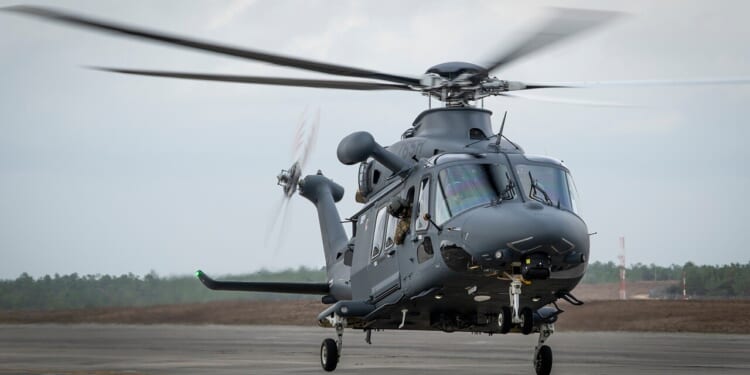The partially destroyed helicopter is intended to give students at the Air Force’s 436th Training Squadron experience in dealing with a helicopter—albeit one that will never fly again.
The United States Air Force recently awarded a $173 million contract to aerospace firm Boeing for an additional eight MH-139A Grey Wolf helicopters. That increased the order of record to 34. The air service previously received 18 of the rotary aircraft, with a dozen from the low-rate initial production (LRIP) lots. The first four were delivered in August 2022.
What to Know About the MH-139A Grey Wolf Helicopter
- Year Introduced: 2020
- Number Built: Unknown; 84 planned
- Length: 54.7 ft (16.67 m)
- Rotor Diameter: 45.2 ft (13.78 m)
- Weight: 14,110 lb (6,400 kg) MTOW
- Engines: Two Pratt & Whitney PT6C-67C turboshaft; 1,100 shp
- Top Speed: 135 knots (155 mph, 250 km/h)
- Range: 225 nmi (259 mi, 416.7 km)
- Service Ceiling: 20,000 ft (6,100 m)
- Loadout: Two M240 7.62mm machine guns;
- Aircrew: 2 (pilot, flight engineer)
The twin-engine helicopters are based on the Leonardo AW139 civilian helicopter and modified for military use. The Grey Wolf has been touted as a modern, versatile aircraft offering greater range, speed, and endurance than the UH-1N Huey it will eventually replace. The Air Force expects to eventually acquire a total of 80 MH-139As as it retires its aging Huey fleet. Production of the airframes will continue at Leonardo’s facilities in northern Italy, with final assembly carried out at Boeing’s Philadelphia plant.
“The MH-139A Grey Wolf represents the best of partnership and proven capability,” said Robert Beyer, MH-139 senior program manager at Leonardo Helicopters. “By building on the trusted AW139 platform, we’ve been able to deliver a versatile aircraft to the warfighter that is already demonstrating its value to the US Air Force. With each new lot, we are proud to continue strengthening national security missions while supporting American manufacturing and jobs.”
Why Did the Air Force Buy a Crashed Bell Huey?
The news of the acquisition of the eight new Grey Wolf aircraft follows an announcement from the Air Force’s Air Combat Command that the service also acquired a UH-1 Iroquois helicopter that can only be described as having seen better days.
According to the ACC, the particular UH-1 “crashed in 2023 during a training flight at the Wyoming Air National Guard Base in Cheyenne.” All three of the aircrew members on board survived the crash, but the aircraft was too damaged to be returned to service.
Instead of heading to the scrap yard, however, the Iroquois was transferred to the Air Force’s 436th Training Squadron. The unit “prides itself on premier education and multimedia production for some of the Air Force’s most vital functions,” notably the Aircraft Mishap Investigation Course.
“The acquisition of the UH-1 will give 100 percent hands-on training and experience to AMIC, Life Science Equipment Investigation, Weapons and Occupational Safety students,” said Capt. Matthew Greene, 436th TRS flight safety commander.
Even transporting the helicopter, since nicknamed “Huey,” became a team-building exercise. It required a “coordinated effort” from multiple units, including the Air Force Global Strike Command, ACC, and Air Mobility Command, as well as the Wyoming Air National Guard’s 153rd Airlift Wing and the 317th Airlift Wing from Dyess Air Force Base (AFB).
The damaged 2.5-ton helicopter was transported from the Wyoming ANGB in Cheyenne to Dyess in a Lockheed Martin C-130J Super Hercules, providing an opportunity for high-pressure altitude training.
“The Flight Safety cadre wanted to have all labs in person to provide excellent hands-on training,” added Greene.
The damaged UH-1 has since arrived at Dyess AFB. It will serve as a training aid to help keep the remaining Huey fleet in service, until the remaining MH-139A Grey Wolf helicopters on order finally enter service and the final UH-1s can be retired.
About the Author: Peter Suciu
Peter Suciu has contributed over 3,200 published pieces to more than four dozen magazines and websites over a 30-year career in journalism. He regularly writes about military hardware, firearms history, cybersecurity, politics, and international affairs. Peter is also a contributing writer for Forbes and Clearance Jobs. He is based in Michigan. You can follow him on Twitter: @PeterSuciu. You can email the author: [email protected].
Image: Wikimedia Commons.

















